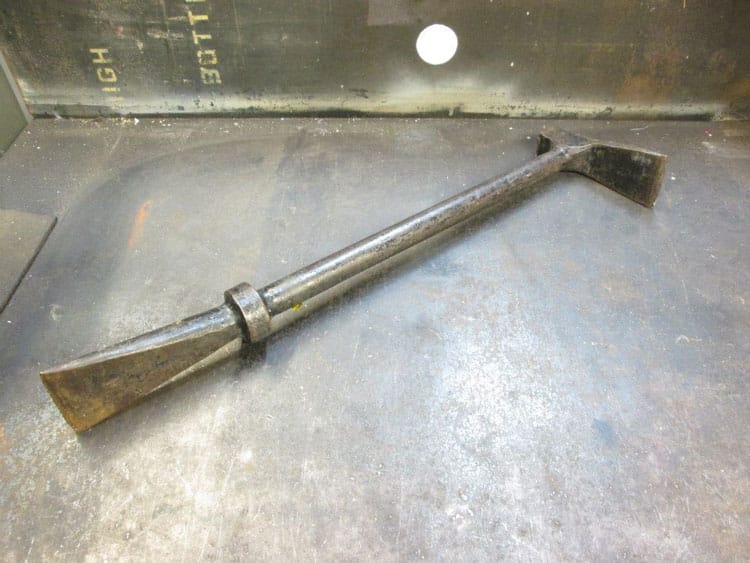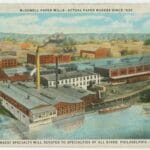Firefighters face intense situations daily, requiring specialized tools to navigate hazardous environments and save lives. Among these, the Halligan bar stands out as an indispensable asset, a symbol of ingenuity and a testament to the evolving nature of firefighting. This article delves into the captivating history of the Halligan bar, exploring its origins, evolution, and enduring significance in the world of firefighting.
History of the Halligan Bar
Imagine a time before the late 1940s, when firefighters battling blazes grappled with cumbersome tools ill-equipped for rapid entry. Forcing entry into a burning building was a time-consuming and often perilous endeavor. This all changed thanks to the innovation of Hugh Halligan, a fire chief in New York City. Recognizing the need for a more efficient and effective tool, Halligan revolutionized firefighting with the invention of the now-iconic Halligan bar.
Crafted from a single piece of heavy-duty steel, the Halligan bar features a distinctive three-part design:
- Adz: The wedge-shaped blade provides leverage for prying open doors, windows, and other obstructions.
- Pick: This pointed end is strategically employed to breach locks, pierce through materials, and access tight spaces.
- Fork: The two-pronged fork creates leverage for prying, spreading, and manipulating objects.
This ingenious design, coupled with its relatively lightweight nature, enabled firefighters to perform forcible entry more swiftly and safely. Its versatility extended beyond doors and windows, finding applications in various rescue scenarios, including vehicle extrication and structural collapse.
Why was the Halligan bar invented?
Prior to the Halligan bar’s arrival, firefighters relied on an assortment of tools, each with its limitations, to gain entry into burning structures. This cumbersome approach was inefficient and often hindered rescue efforts. Chief Hugh Halligan recognized this critical need for a single, versatile tool that would empower firefighters to act swiftly and effectively.
The Halligan bar’s invention marked a paradigm shift in firefighting tactics. Its design ingeniously combined the functionalities of multiple tools into one compact and user-friendly device. This innovation significantly improved the speed and efficiency of forcible entry, enabling firefighters to reach those trapped inside burning buildings faster and safer.
The Halligan bar’s impact reverberated through firefighting departments worldwide, becoming an indispensable tool in their arsenals. Beyond its practical applications, the Halligan bar has come to embody firefighter ingenuity, resourcefulness, and unwavering commitment to safeguarding lives and property.
What is the history of the Halligan hook?
Amidst the chaos of a raging cellar fire in the mid-1940s, FDNY Deputy Chief Hugh Halligan found himself frustrated by the limitations of existing tools. The available equipment for prying open doors and windows proved clunky, heavy, and inadequate for the task at hand. This experience ignited a spark of innovation in Halligan’s mind.
Drawing inspiration from the New York roof hook and the Chicago Hook, Halligan set out to design a groundbreaking tool. His vision materialized into the Halligan hook, a single, versatile instrument that would forever alter forcible entry techniques in firefighting. This lightweight and maneuverable tool incorporated an adz, pick, and fork, enabling firefighters to breach doors, pry open windows, and even assist with ventilation—a true game-changer in the field.
The Halligan hook’s reputation for efficacy spread rapidly, quickly becoming a staple in fire departments worldwide. Its introduction revolutionized forcible entry practices, significantly enhancing firefighter safety and efficiency during rescue operations.
The legacy of the Halligan hook extends beyond its initial design. Over time, refinements and variations, like the Pro-Bar, emerged, adapting to modern firefighting challenges and building construction techniques. This ongoing evolution underscores the profound impact of Halligan’s invention and its enduring relevance in today’s firefighting landscape.
Key Takeaways:
- Invention and Inspiration: FDNY Deputy Chief Hugh Halligan invented the Halligan hook in the mid-1940s, drawing inspiration from existing tools to address their limitations.
- Design and Functionality: The Halligan hook combined an adz, pick, and fork, providing a versatile tool for various forcible entry tasks, including breaching doors and prying open windows.
- Impact on Firefighting: Its introduction marked a turning point in forcible entry techniques, significantly improving firefighter speed, efficiency, and safety during emergencies.
- Evolution and Adaptation: The Halligan hook has undergone refinements and variations, such as the Pro-Bar, to meet evolving firefighting needs and modern building construction practices.
What are the three parts of the Halligan bar?
The Halligan bar’s effectiveness lies in its ingenious three-part design, each component playing a crucial role in tackling a range of firefighting challenges:
- The Adz: This wedge-shaped blade acts as a powerful lever, ideal for prying open stuck doors, windows, and other obstacles. Its flat surface provides ample contact area for applying maximum force.
- The Pick: Located at the opposite end of the adz, the pick offers precision and force. Its pointed end is indispensable for breaching locks, prying open jammed objects, and accessing confined spaces.
- The Fork: Situated between the adz and the pick, the fork, with its two prongs, acts as another leveraging point. It’s particularly effective for prying apart metal bars, creating separation in building materials, and providing additional leverage when used in conjunction with the adz or pick.
The synergy of these three components makes the Halligan bar a versatile tool, capable of addressing a multitude of scenarios. However, its efficacy is intrinsically linked to the skill of the firefighter wielding it. Rigorous training is essential for firefighters to master the art of utilizing each part of the Halligan bar effectively and safely in high-pressure situations.
What Halligan does FDNY use?
The FDNY, renowned for its rigorous standards and demanding operational environment, relies on the Halligan bar as a cornerstone of its forcible entry arsenal. While the fundamental design remains consistent, the FDNY, like many other departments, utilizes variations tailored to specific needs.
Factors influencing the choice of Halligan bar include length, weight, and material composition. For instance, shorter bars offer enhanced maneuverability in confined spaces, while longer, heavier bars provide increased leverage for breaching reinforced structures. The selection process reflects the FDNY’s commitment to equipping its firefighters with the most effective tools for every situation.
The evolution of the Halligan bar continues. Ongoing research and development explore new materials, ergonomic designs, and technological integrations. The FDNY remains at the forefront of these advancements, continually seeking ways to enhance the tool’s effectiveness, firefighter safety, and overall operational efficiency.
What is a Halligan and axe called?
In firefighting jargon, the dynamic duo of the Halligan bar and the flathead axe is often referred to as “the irons,” “a married set,” or simply “the irons.” This nomenclature underscores the inseparable bond between these two essential tools, reflecting their complementary roles in tackling fireground challenges.
The Halligan bar, with its prying, twisting, punching, and striking capabilities, combined with the cutting and breaching prowess of the flathead axe, forms a formidable alliance. This powerful partnership enables firefighters to:
- Breach Doors and Windows: The Halligan bar’s prying and leveraging capabilities, coupled with the axe’s striking force, allows for rapid entry into secured structures.
- Ventilate Structures: By strategically creating openings, these tools facilitate the release of heat and smoke, improving visibility and creating a safer environment for firefighters and potential victims.
- Extricate Trapped Individuals: From vehicles to collapsed structures, “the irons” empower firefighters to overcome obstacles and free individuals trapped in perilous situations.
More than individual tools, this iconic pair symbolizes a firefighter’s readiness, skill, and unwavering commitment to protecting lives and property.
What is the difference between a hooligan and a Halligan?
While their names sound remarkably similar, the Halligan bar and the Hooligan bar, both integral to firefighting, exhibit distinct characteristics that differentiate their roles and applications.
Construction and Durability:
- Halligan Bar: Forged from a single piece of high-grade steel, the Halligan bar boasts exceptional strength and durability, renowned for its ability to withstand extreme conditions.
- Hooligan Bar: Constructed by assembling three separate components, the Hooligan bar might offer a degree of flexibility. However, this design could potentially make it less resilient than its single-piece counterpart, particularly under extreme stress.
Size and Versatility:
- Halligan Bar: Typically available in two standard sizes, the Halligan bar prioritizes strength and reliability for its primary purpose – forcible entry.
- Hooligan Bar: Offered in a wider range of sizes, the Hooligan bar caters to more diverse tasks. While effective for forcible entry, its design might lend itself to additional applications beyond breaching.
Quality and Reputation:
- Halligan Bar: The original Halligan bars, crafted with meticulous attention to detail and time-tested manufacturing processes, have garnered a reputation for unparalleled quality and dependability, making them highly sought-after by fire departments globally.
- Hooligan Bar: While some Hooligan bars adhere to high standards, their quality can vary depending on the manufacturer and materials used.
Here’s a table summarizing the key differences:
| Feature | Halligan Bar | Hooligan Bar |
|---|---|---|
| Construction | Single-piece metal | Three assembled parts |
| Sizes | Two sizes | Four sizes |
| Primary Use | Forcible entry | Various, including forcible entry |
| Quality Note | Originals known for high quality | Quality can vary |
The choice between a Halligan and a Hooligan bar often boils down to specific departmental needs, operational protocols, and budget considerations. The firefighting community continually explores new techniques and technologies, suggesting that the future might hold even more refined and specialized tools for tackling ever-evolving fireground challenges.
- SYBAU See You Baby Meaning: Gen Z Slang Evolves - July 1, 2025
- Unlock Your Inner Youth: Lifestyle Secrets for a Vibrant Life - July 1, 2025
- Decode SYBAU Meaning: Gen Z Slang Explained - July 1, 2025







1 thought on “A Firefighter’s Best Friend: Unlocking the History of the Halligan Bar”
Comments are closed.